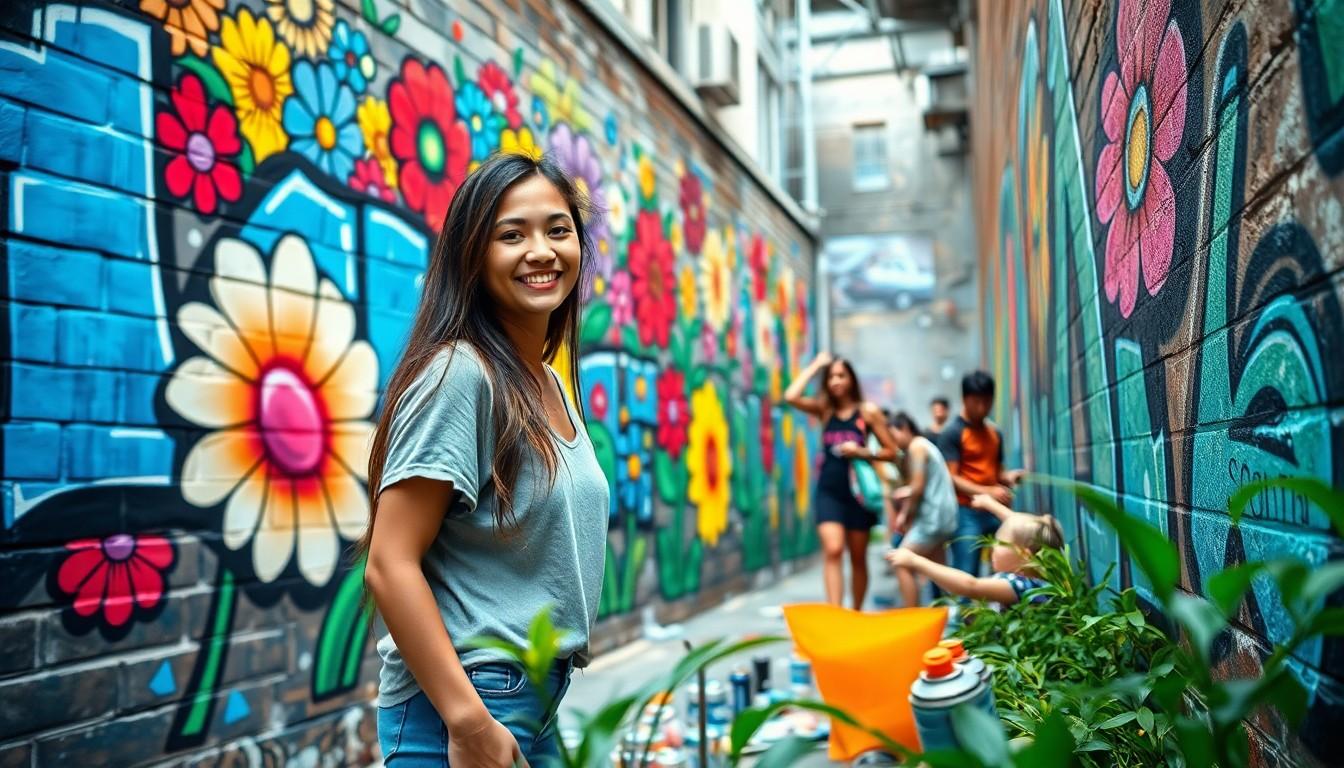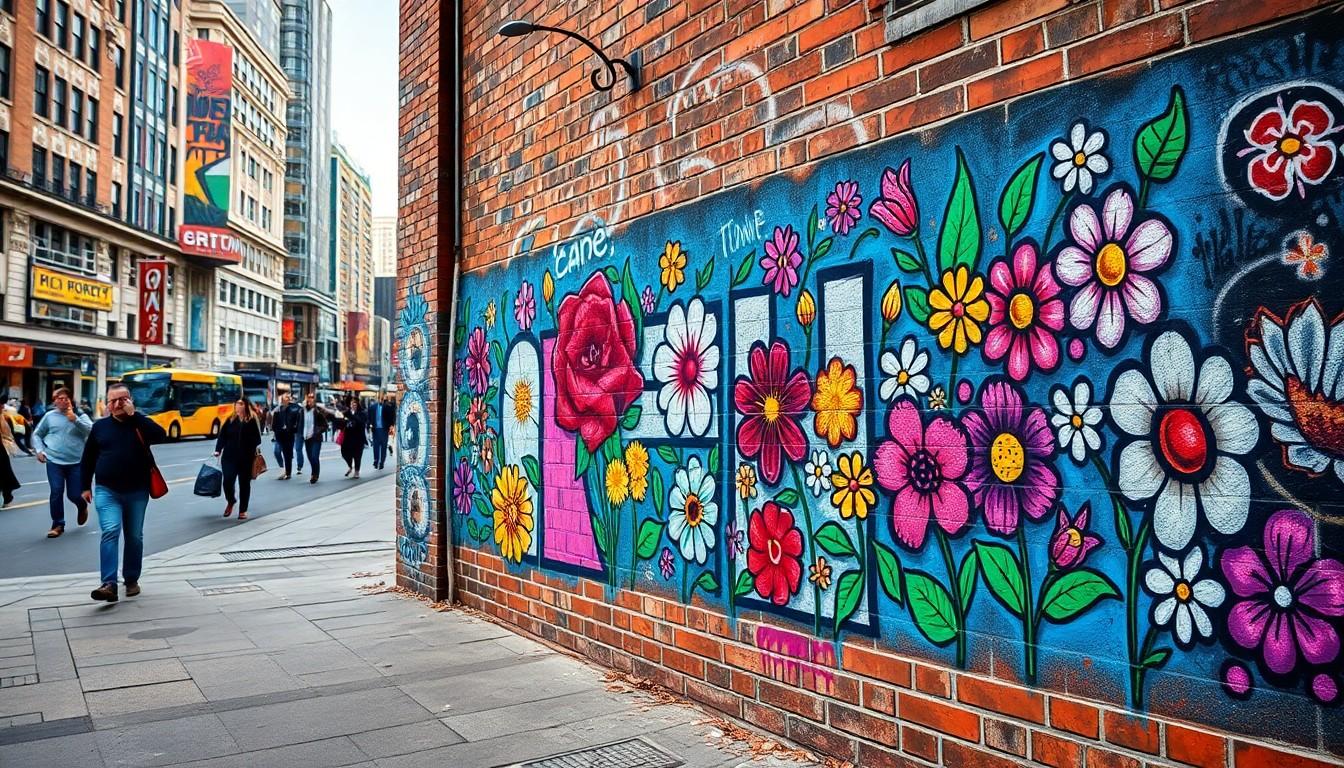Phone:
(701)814-6992
Physical address:
6296 Donnelly Plaza
Ratkeville, Bahamas.

In a world where concrete jungles reign supreme, graffiti flowers are the unexpected bursts of color that challenge the mundane. Imagine strolling down a dreary alley only to be greeted by vibrant blooms painted on the walls, transforming the urban landscape into a whimsical garden. These artistic expressions not only brighten up the streets but also spark conversations about beauty, rebellion, and the power of creativity.
Graffiti flowers represent a unique intersection of art and urban space. Artists use vibrant colors to create stunning images on walls, turning bland cityscapes into expressive displays. These murals often highlight themes of nature and beauty, providing a stark contrast to the concrete surroundings—an effect that can also be simulated using an AI image generator for digital art concepts.
Many graffiti flowers incorporate various styles, blending techniques from street art and traditional painting. Spray paint emerges as a primary medium, allowing for bold expressions. Other materials, such as stencils and brushes, enhance detail and depth.
Locations for these murals vary widely. Some appear in high-traffic areas, attracting daily commuters, while others hide in alleys, creating an element of surprise. Communities often embrace these creations, seeing them as landmarks that contribute to local identity.
Environmental messages frequently emerge through this art form. Artists convey themes like ecological awareness and the importance of green spaces. These works can spark conversations about sustainability and inspire efforts to enhance urban landscapes.
In recent years, projects engaging the public in the creation of graffiti flowers have grown. Collaborations between artists and residents foster community spirit. Such initiatives allow participants to express their ideas and connect with their neighborhoods.
Graffiti flowers serve as a testament to resilience and adaptability in urban environments. They challenge perceptions of traditional beautification efforts, showcasing creativity. Urban planners increasingly recognize their impact on societal and psychological well-being.

Graffiti flowers represent a unique fusion of creativity and urban expression. Artists transform city landscapes with floral murals that challenge conventional aesthetics.
Various techniques contribute to creating vibrant graffiti flowers. Spray paint serves as the primary medium, allowing artists to achieve vivid colors. Stencils facilitate precise shapes, offering a level of detail that enhances the overall design. Brushwork often complements these techniques, adding texture and depth. Some artists incorporate mixed media, blending elements like collage or digital projections for a contemporary flair. Styles range from abstract interpretations to hyper-realistic depictions, showcasing each artist’s unique vision and skill set.
Several artists have gained recognition for their contributions to the graffiti flower movement. Famed street artist Banksy often incorporates floral motifs into his politically charged works. Another influential figure, Kelsey Montague, is known for interactive murals that invite public engagement. French artist Oakoak creates whimsical characters among his floral designs, merging humor with artistry. Through their innovative approaches, these artists have redefined urban landscapes, leaving lasting impressions on city dwellers and visitors alike.
Graffiti flowers embody vibrant expressions within urban landscapes, influencing cultural narratives and community interactions.
During the 1960s, graffiti emerged as a form of rebellion, with artists using spray paint to voice dissent. This movement gradually evolved into various sub-genres, including graffiti flowers. By the late 1980s, artists began incorporating floral themes to contrast gritty urban environments. Flower imagery symbolizes hope and beauty, presenting stark contrasts to the surrounding concrete. Urban murals made their way into public consciousness, fostering discussions about art’s role in society. As visibility increased, graffiti flowers became a cultural commentary on environmental awareness and urban resilience.
In contemporary settings, graffiti flowers reflect an evolving urban narrative. Artists like Banksy and Kelsey Montague utilize florals to challenge societal norms and engage communities. Interactive murals invite local participation, fostering pride and ownership among residents. Urban planners recognize these artworks for their ability to transform spaces and boost mental well-being. Moreover, mixed media techniques enrich the visual experience, blending traditional spray paint with digital elements. This fusion showcases artists’ innovative approaches, allowing for unique expressions that resonate with broader audiences.
Graffiti flowers serve as a catalyst for environmental awareness. Their vibrant designs often highlight the importance of green spaces in urban settings. Artists frequently infuse themes of ecology into their work, encouraging conversations about sustainability. Through these murals, they advocate for the preservation of nature amid concrete structures.
Community engagement plays a vital role in the creation of graffiti flowers. Neighborhood residents come together to express their love for nature and art, fostering a sense of belonging. This collaboration not only beautifies urban areas but also promotes ecological stewardship. Studies indicate that such initiatives can lead to improvements in local biodiversity and the promotion of public green spaces.
Environmental messages within these artworks resonate with broader audiences. For instance, some murals depict endangered plant species, raising awareness about conservation efforts. This artistic approach captures public attention, often prompting discussions on climate change and urban pollution. The juxtaposition of flowers against grim urban backdrops symbolizes hope and resilience in the face of environmental challenges.
Urban planners increasingly recognize the positive impacts of these murals. Enhancing mental well-being becomes a priority when incorporating art into public spaces. Graffiti flowers contribute to a more inviting atmosphere, leading to increased foot traffic and community interaction. Through this transformative process, urban environments become more sustainable and aesthetically pleasing.
The continued evolution of graffiti flowers reflects broader societal shifts toward environmental consciousness. As artists explore new techniques and themes, they inspire others to engage with their surroundings. Ultimately, these vibrant murals create a legacy of environmental advocacy and community spirit.
Graffiti flowers have emerged as a powerful symbol of creativity and community in urban landscapes. These vibrant murals not only beautify concrete jungles but also spark important conversations about environmental stewardship and social connection.
As artists continue to push boundaries with their unique styles and messages, the impact of graffiti flowers will only grow. They challenge the notion of public spaces and redefine how communities engage with art.
In an era where urban environments often feel disconnected from nature, graffiti flowers remind everyone of the beauty that can flourish amidst the chaos. Their legacy will inspire future generations to appreciate art’s role in promoting ecological awareness and community identity.